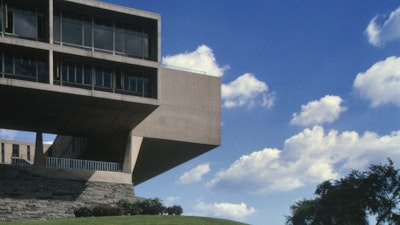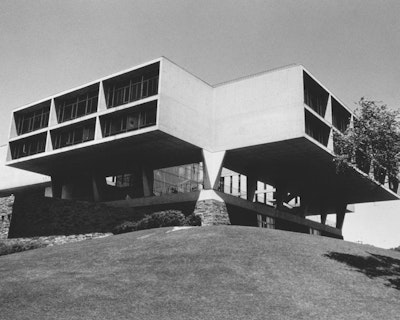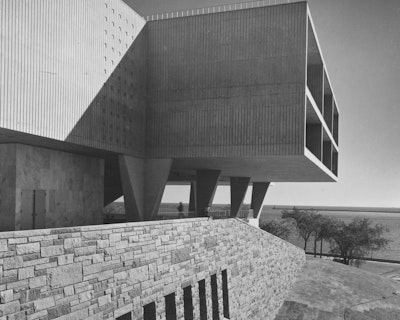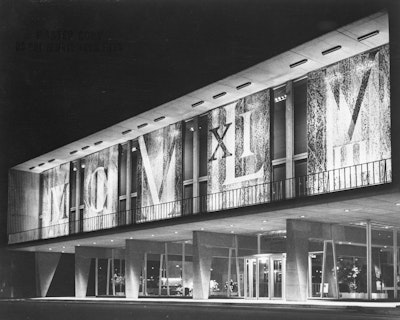War Memorial Center


Overview
After World War II, Finnish architect Eliel Saarinen was commissioned to create an arts complex on the Lake Michigan shore, with a museum, performing arts center, and veterans’ memorial. After the architect died in 1950, his son Eero Saarinen took over the project. When fundraising proved insufficient, Saarinen reconfigured the plan without the performance space. Construction began in 1955, supervised by Milwaukee architects Maynard W. Meyer & Associates.
Eero Saarinen’s innovative design for the War Memorial Center was influenced by the abstract geometry of modern French architect Le Corbusier. Saarinen incorporated many of Le Corbusier’s ideas: lifting the bulk of a building off the ground on reinforced columns; eliminating load-bearing walls to allow a freeform façade and open floor plan; and using plazas, courtyards, and rooftop terraces to allow an interaction between internal and external spaces.
The building, a concrete, steel, and glass cruciform floating on a pedestal, included three major components, as Saarinen described:
“One is the base, which builds the mass up to the city level and contains an art museum; the second, on the city level, is the memorial court with a pool. The court is surrounded by the polyhedron-shaped piers, which support the building and also make frames for the breathtaking views of the lake and sky. The third part is the superstructure, cantilevered outward thirty feet in three directions, which contains the meeting halls and offices of the veterans’ organizations.”
In 1957, the War Memorial Center was dedicated “To Honor the Dead by Serving the Living.” The western face of the building features a memorial mural by Wisconsin artist Edmund Lewandowski, a mosaic of 1.4 million pieces of marble and glass. The original Museum had a dramatic entryway from the central courtyard, with stairs down to three large exhibition galleries. A 1975 addition designed by David Kahler greatly expanded the Museum’s gallery space.
Gallery
Eero Saarinen
Modernist architect and designer Eero Saarinen (1910–1961) was born in Finland, and emigrated to the U.S. with his family at age 13. His father, Eliel Saarinen, was an architect, his mother, Louise Gesellius, a sculptor. He studied at the Cranbrook Academy of Art, near Detroit; his father, who designed the campus and served as director, convinced Eero that architecture should encompass a “total environment”–landscapes, buildings, furniture, and décor. Starting in 1936, Saarinen worked with his father, both in his architecture firm and as an instructor at Cranbrook. Saarinen started his own business after his father died in 1950.
As a designer, Saarinen developed several new furniture forms, including the first designs for furniture molded from laminated wood, working with Cranbrook colleague with Charles Eames. In 1948, Saarinen designed the Womb collection, chairs intended to make users feel as secure and cozy as a fetus. His 1956 Pedestal Group, including the popular Tulip Chair, eliminated the “slum of legs” in homes; all tables and chairs in the collection rest on a central pedestal, balanced by a round disc on the floor.
As an architect, Saarinen became a leader of a second generation of modernists. He built on his predecessors’ work using new construction technology to create modern architectural forms, but disparaged “the measly ABC,” the simple, abstract compositions of early modernism. He refused to develop a singular style, preferring to flex designs to the needs of clients, shifting between the sleek machine aesthetic of the International Style and the free-form geometric concrete structures pioneered by Le Corbusier.
Saarinen’s innovative design for Milwaukee’s War Memorial Center, which he developed after the commissioned architect, his father Eliel Saarinen, died, was directly influenced by Le Corbusier’s abstract geometry. The building’s design was later praised by Time magazine as “one of the country’s finest examples of modern architecture put to work for civic purposes.”
Today, Saarinen’s bold designs remain symbolic expressions of post-war American identity. His best-known works, such as the St. Louis Gateway Arch and the TWA Terminal at New York’s JFK airport, incorporate new dynamic forms and structural innovations. Saarinen’s exuberant visual effects in architecture and design captured the optimism of an era and a national ideal of boundless opportunity.



